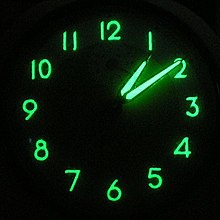Radium dial

Radium dials are watch, clock and other instrument dials painted with radioluminescent paint containing radium-226. The 1900s (decade) were the peak of radium dial production, as radiation poisoning was then unknown; subsequently, radium dials have largely been replaced by phosphorescent- or occasionally tritium-based light sources.
Brands
- Undark produced by the United States Radium Corporation
- Luna produced by the Radium Dial Company
- Marvelite produced by the Cold Light Manufacturing Company (a subsidiary of the Radium Company of Colorado)
History
Radium dials were almost always painted by young women, who used to 'point' their brushes by licking and shaping the bristles prior to painting the fine lines and numbers on the dials. This practice resulted in the ingestion of radium, which caused serious jaw-bone degeneration and malignancy and other dental diseases reminiscent of phossy jaw. The disease, radium-induced osteonecrosis, was recognized as an occupational disease in 1925 after a group of radium painters, known as the Radium Girls, from the United States Radium Corporation sued. By 1930, all dial painters stopped pointing their brushes by mouth. Stopping this practice drastically reduced the amount of radium ingested and therefore, the incidence of malignancy, to zero by 1950 among the workers who were studied.
"Luminous Processes employees interviewed by a journalist in 1978 had been left ignorant of radium's dangers. They were told that eliminating lippointing had ended earlier problems. They worked in unvented rooms, they wore smocks that they laundered at home. Geiger counters could pick up readings from pants returned from a dry cleaner and from clothes stored away in a cedar chest."[1]
Safety
Although old radium dials may no longer produce light, this is frequently due to the breakdown of the crystal structure of zinc sulfide rather than the radioactive decay of the radium, which has a half-life of about 1600 years,[2] so even very old radium dials remain radioactive. Radium paint can be ingested by inhaling flaking paint particles. The alpha particles emitted by the radium will kill off surrounding bone tissue, resulting in a condition loosely referred to as radium jaw.
The most common isotope of Radium, Radium-226, which emits ionizing radiation: [alpha particles].[2] Alpha particles are shielded by even light amounts of material.
Radium does not emit anything other than alpha decay particles. Radium-226 according to NUDAT and United States Nuclear Commission data clearly indicates that 100% of radium-226 decay is alpha particles only.
See also
Sources
- Radium Girls: Women and Industrial health reform, 1910–1935, ISBN 978-0-8078-4640-7
